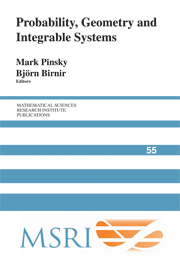Book contents
- Frontmatter
- Contents
- Preface
- Henry McKean: A tribute by the editors
- Bitangential direct and inverse problems for systems of differential equations
- Turbulence of a unidirectional flow
- Riemann–Hilbert problem in the inverse scattering for the Camassa–Holm equation on the line
- The Riccati map in random Schrödinger and random matrix theory
- SLE6and CLE6 from critical percolation
- Global optimization, the Gaussian ensemble, and universal ensemble equivalence
- Stochastic evolution of inviscid Burgers fluid
- A quick derivation of the loop equations for random matrices
- Singular solutions for geodesic flows of Vlasov moments
- Reality problems in the soliton theory
- Random walks and orthogonal polynomials: some challenges
- Integration of pair flows of the Camassa–Holm hierarchy
- Landen Survey
- Lines on abelian varieties
- Integrable models of waves in shallow water
- Nonintersecting Brownian motions, integrable systems and orthogonal polynomials
- Homogenization of random Hamilton–Jacobi–Bellman Equations
Nonintersecting Brownian motions, integrable systems and orthogonal polynomials
Published online by Cambridge University Press: 27 June 2025
- Frontmatter
- Contents
- Preface
- Henry McKean: A tribute by the editors
- Bitangential direct and inverse problems for systems of differential equations
- Turbulence of a unidirectional flow
- Riemann–Hilbert problem in the inverse scattering for the Camassa–Holm equation on the line
- The Riccati map in random Schrödinger and random matrix theory
- SLE6and CLE6 from critical percolation
- Global optimization, the Gaussian ensemble, and universal ensemble equivalence
- Stochastic evolution of inviscid Burgers fluid
- A quick derivation of the loop equations for random matrices
- Singular solutions for geodesic flows of Vlasov moments
- Reality problems in the soliton theory
- Random walks and orthogonal polynomials: some challenges
- Integration of pair flows of the Camassa–Holm hierarchy
- Landen Survey
- Lines on abelian varieties
- Integrable models of waves in shallow water
- Nonintersecting Brownian motions, integrable systems and orthogonal polynomials
- Homogenization of random Hamilton–Jacobi–Bellman Equations
Summary
Consider n nonintersecting Brownian motions on ℝ, which leave from p definite points and are forced to end up at q points at time t = 1. When n → ∞, the equilibrium measure for these Brownian particles has its support on p intervals, for t ∽ 0, and on q intervals, for t ∽ 1. Hence it is clear that, when t evolves, intervals must merge, must disappear and be created, leading to various phase transitions between times t = 0 and 1.
Near these moments of phase transitions, there appears an infinite-dimensional diffusion, a Markov cloud, in the limit n ↗ ∞, which one expects to depend only on the nature of the singularity associated with this phase change. The transition probabilities for these Markov clouds satisfy nonlinear PDE’s, which are obtained from taking limits of the Brownian motion model with finite particles; the finite model is closely related to Hermitian matrix integrals, which themselves satisfy nonlinear PDE’s. The latter are obtained from investigating the connection between the Karlin-McGregor formula, moment matrices, the theory of orthogonal polynomials and the associated integrable systems. Various special cases are provided to illustrate these general ideas. This is based on work by Adler and van Moerbeke.
1. Introduction
This lecture in honor of Henry McKean forms a step in the direction of understanding the behavior of nonintersecting Brownian motions on ℝ (Dyson's Brownian motions), when the number of particles tends to ∞. It explains a novel interface between diffusion theory, integrable systems and the theory of orthogonal polynomials. These subjects have been at the center of Henry McKean's oeuvre.
Information
- Type
- Chapter
- Information
- Probability, Geometry and Integrable Systems , pp. 373 - 396Publisher: Cambridge University PressPrint publication year: 2008
